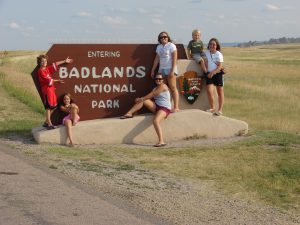
Entering Badlands National Park
In honor of the 100th Anniversary of the National Park Service (NPS), over the course of the year Live a Memory will highlight some of the wonderful Parks, Monuments, and Memorials that you can visit, enjoy, and cross off your Bucket List. This week we will visit Badlands National Park!
Imagine a land where skyscrapers, cathedrals, and houses are replaced by spires, pinnacles, buttes, and bluffs. Imagine a land where a sunset looks as if colors from a rainbow have been washed from the sky and smeared across the landscape like an impressionist painting come to life. Imagine a land where American Bison, Bighorn Sheep, Mule Deer, and Bobcats roam freely and rule the land. Imagine a land where a great inland sea stood millions of years ago and the now fossilized inhabitants introduce themselves to the world each day as erosion slowly brings them into the sunlight. Imagine yourself visiting Badlands National Park.
Located in the southwest corner of South Dakota, Badlands National Park is a place where the Great Plains come to an end and the drive to the Black Hills of South Dakota (and ultimately the Rockies) begins. The Badlands is a must see spot for anyone traveling east or west along Interstate 90 in South Dakota. The main entry point is located at exit 131 on I-90. The park is approximately 85 miles east of Rapid City and a little over 100 miles east of Mount Rushmore, Custer State Park, Crazy Horse Memorial, Wind Cave National Park, and Jewel Cave National Monument – all in the delightful Black Hills of South Dakota.
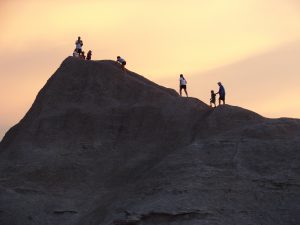
Climbing in Badlands National Park
Known as mako sica (land bad) by the Lakota people, and les mauvais terres pour traverse (bad lands to travel through) by French-Canadian fur trappers, this incredible region is anything but bad to the visitor today. Having been to the Badlands a number of times now, I can say that it is a place that captures you with its desolate beauty, with its amazing geology ranging from buttes and spires to grasslands, with the wildlife that is all around you (yet hidden at the same time), and with a quiet and solitude that fills the air. And if you like to hike and climb – well, the Badlands just scream “come on out and climb me!”
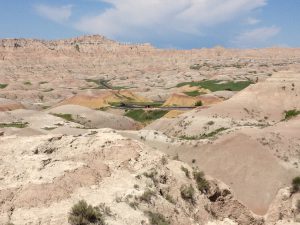
Incredible colors in Badlands National Park
The peak season for a visit to Badlands National Park is the summer, however, the park is open year round. During a summertime visit you will enjoy the heat of the afternoon and the refreshing coolness of the evening. From experience I can say that there is no bad time of day to visit, but the most incredible moments are at sunrise and sunset. The oranges and yellows, the reds and purples, and the greens and browns will amaze you at sunrise and sunset!
Besides a delightful drive along Badlands Loop Road and enjoying the scenery, the park offers so much more! Head over to the Ben Reifel Visitor Center (which my wife says has the coolest gift shop) and check out the visitor programs they have to offer. The Geology Walk, the Fossil Talk, the Junior Ranger Program, and Night Sky Viewing are all wonderful programs available to park visitors. And if you visit the park from Friday, July 8 to Sunday, July 10 you can enjoy the 2016 Badlands Astronomy Festival. This is one of the main events each summer!
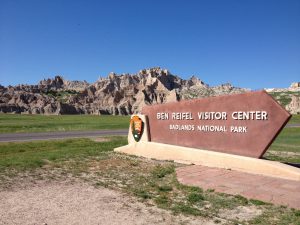
Ben Reifel Visitor Center
As you plan your trip, to learn more about Badlands National Park we recommend that you visit the Badlands pages at the National Park Service website – https://www.nps.gov/badl/index.htm. The website contains a ton of great information about the park and we encourage you to spend the time to check it out.
And to help make your trip even more wonderful, we contacted Badlands National Park and spoke to Paul Ogren who kindly spent a few minutes with us to share his unique insight on the park. Paul has been a member of the Badlands National Park staff for the past 9 summers and has been coming back to the Badlands for the past 30+ years! Paul is from Minneapolis, MN where he was a broadcast engineer. Paul explained that even though he has been coming to the park for more than 30 years, he still sees “something new almost every day as I hike or drive the park.” We thank Paul for the opportunity to talk about the park and sharing his answers to our questions! The following are the questions and answers from our conversation.
——————————————————————–
1. What are the top 3 attractions in the park?
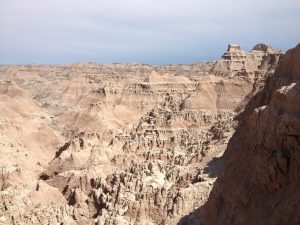
Incredible geology!
The Geology is the first attraction. Buttes, and spires, and grasslands abound within the park. The next attraction is the Wildlife. During a visit you may be able to see animals such as bison, bighorn sheep, pronghorn antelope, mule deer, swift fox, and many, many others. The third attraction is the Paleontology. Fossils of saber-toothed cats, giant rhinos, camels, and three-toed horses, in addition to many others have been found at Badlands National Park. The park holds some of the best fossil beds from Oligocene era.
2. What is a hidden treasure in your park?
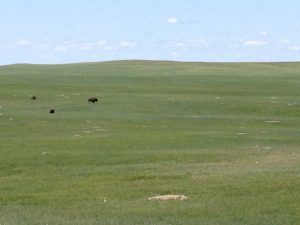
Bison in the rolling prairie.
The Sage Creek Wilderness Area is a true hidden treasure in the park. This area of the park has rolling prairie surrounded by eroded buttes. You will also find bison, pronghorn, and mule deer roaming in the Sage Creek basin.
(The Sage Creek Wilderness Area is located 25 miles west of the Ben Reifel Visitor Center and south of Sage Creek Rim Road. The Wilderness Area is only accessible by hiking.)
3. Can visitors stay overnight in the park?
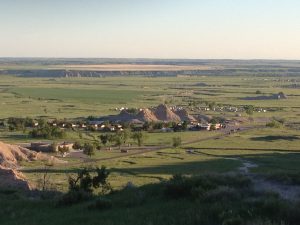
Cedar Pass Lodge
The delightful cabins of Cedar Pass Lodge located right behind the Ben Reifel Visitor Center are available for rental. Camping within the park is available at the Cedar Pass Campground also located near the Ben Reifel Visitor Center. Camping is also available at the Sage Creek Campground, however, this is a primitive campground.
(And, be careful for the occasional bison that may wander through!)
4. When staying outside of the park, where do visitors typically stay?
When lodging outside of the park, visitors often stay in the town of Wall, SD (30 miles northwest of the Ben Reifel Visitor Center) and Rapid City (85 miles west of Badlands National Park).
5. When was your national park founded?
The Badlands was authorized as a National Monument in 1929 and was established as a National Monument in 1939. In 1978 it became a National Park.
6. How many visitors usually visit the park every year?
The park is open all year and averages 850,000 to 950,000 visitors annually.
7. What is the best time of year to visit the park?
The most popular time of year to visit is in the summertime, however, a great time to visit is right after Labor Day. In early September the number of visitors each day drops substantially, the weather is not as hot as during the summertime, and the animal herds are moving.
8. What is the greatest challenge maintaining the park?
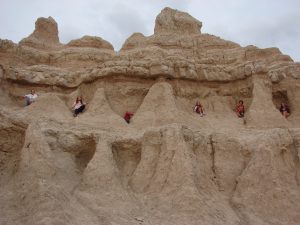
Climbing in the Badlands!
There are no restrictions on people climbing the rock formations in the park, however, that means that sometimes people fall and injure themselves.
9. Are there any special rules for visitors to know while in the park?
Dogs are only allowed in parking lots and in campgrounds. Also, no collecting of the natural resources such as fossil bones or rocks is allowed.
10. What is one of the most frequently asked question from tourists?
Tourists frequently ask questions about the rock formations. How long does it take to get to Mount Rushmore (2 hours / 105 miles) is another question that is often asked. And many times tourists ask how close Custer’s Battlefield is (Little Bighorn Battlefield just south of Crow Agency, Montana, 5 hours 30 minutes / 330 miles)?
11. What kind of animals may be seen in the park?
Badlands National Park is home to many different kinds of animals, both big and small.
(The National Park Service website explains that 39 mammal species, 9 reptile species, 6 amphibian species, 206 bird species, and 69 butterfly species have been seen in the park. https://www.nps.gov/badl/learn/nature/animals.htm)
12. What is the most commonly seen animal in the park?

Bighorn Sheep
The Mule Deer, Bighorn Sheep, and American Bison are some of the most commonly seen animals in the park.
13. What is the most elusive animal in the park?
The Black-Footed Ferret, Swift Fox, and Bobcat are some of the more elusive animals in the park.
14. What is a feature in your park that no other national park has?
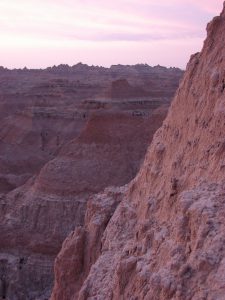
An unique mix of paleontology and geology.
The main feature is the unique mix of paleontology and geology found in Badlands National Park.
15. What kind of activities can a visitor do while in the park?
Hiking, bird watching, animal tracking, daily Ranger Programs, and the wonderful events held throughout the summer. The most popular event is the Astronomy Festival scheduled in 2016 for Friday, July 8 through Sunday, July 10.
https://www.nps.gov/badl/planyourvisit/upload/schedule-of-events-1.pdf
The following are learning opportunities at Badlands National Park in July and August 2016:
Friday, July 1, 2016 Music from these Centennial Lands
Thursday, July 7, 2016 Centennial Wilderness Hike
Friday, July 8, 2016 2016 Astronomy Festival “A Historic Journey through the Stars”
Thursday, July 14, 2016 “National Park Soundscapes” Music in the Park
Thursday, August 25, 2016 NPS Centennial Founder’s Day
16. What is a great activity for children?
The Junior Ranger program is a great activity for children. The Fossil Talk held daily at 10:30 a.m. and 1:30 p.m. is often the most popular event with children.
https://www.nps.gov/badl/planyourvisit/upload/2016-Ranger-Programs.pdf
17. What is a great activity for adults?
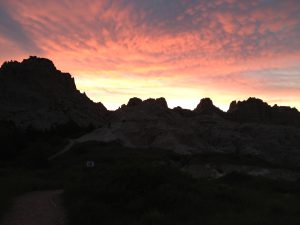
Sunset in the Badlands.
The Geology Walk held daily at 8:30 a.m. is a great activity for adults. The Night Sky Viewing is also very popular with adults.
(Also, Paul Ogren will be giving an informal ornithology walk / talk this summer. If you want to learn about birds in Badlands National Park this will be a great opportunity!)
18. Is there anything else you would like to tell people about Badlands National Park that would make them want to add a visit to their Bucket List?
Badlands National Park and Denali National Park are the only parks where you are allowed to climb and hike wherever you would like to.
——————————————————————–
We hope this information about Badlands National Park was helpful. Let us know how your planning is going and how your visit was by emailing us at liveamemory@gmail.com.
Have a great trip and Live a Memory!
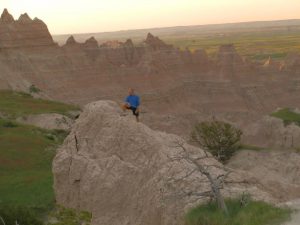
In the morning, Doug in the Badlands.


